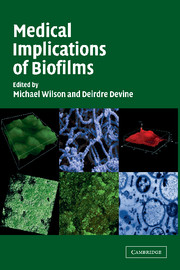Book contents
- Frontmatter
- Contents
- Preface
- List of Contributors
- PART ONE INTRODUCTORY CHAPTERS
- 1 Biofilm-Dependent Regulation of Gene Expression
- 2 Quorum Sensing and Microbial Biofilms
- 3 Antimicrobial Agents and Biofilms
- PART TWO BIOFILMS ON PROSTHETIC DEVICES
- PART THREE ORAL BIOFILMS
- PART FOUR BIOFILMS ON SHEDDING SURFACES
- Index
- References
2 - Quorum Sensing and Microbial Biofilms
Published online by Cambridge University Press: 23 November 2009
- Frontmatter
- Contents
- Preface
- List of Contributors
- PART ONE INTRODUCTORY CHAPTERS
- 1 Biofilm-Dependent Regulation of Gene Expression
- 2 Quorum Sensing and Microbial Biofilms
- 3 Antimicrobial Agents and Biofilms
- PART TWO BIOFILMS ON PROSTHETIC DEVICES
- PART THREE ORAL BIOFILMS
- PART FOUR BIOFILMS ON SHEDDING SURFACES
- Index
- References
Summary
INTRODUCTION
For a long time bacteria were believed to exist as unicellular organisms; however, it is now realized that in nature bacteria are more often found clustered in communities. Within these communities, bacteria are capable of coordinated activity through the use of a sophisticated intercellular communication mechanism called quorum sensing (QS). The capacity to behave collectively as a group has obvious advantages, for example, migration to a more suitable environment/better nutrient supply or adopting a more favourable mode of growth such as sporulation. Recently, QS was discovered to play a role in the formation of biofilms. This latter phenomenon will be the focus of this chapter as we review our current understanding of how QS affects the complex processes of biofilm development. With respect to intercellular communication and biofilms, Pseudomonas aeruginosa is one of the most intensely studied organisms, and therefore, much of this chapter will concentrate on this bacterium.
QUORUM SENSING
QS exists in both Gram-positive and Gram-negative bacteria with obvious differences between the two systems (for reviews, see Dunny and Leonard, 1997; Fuqua, Winans, and Greenberg, 1996). Here, we will focus on Gram-negative bacteria, where the two primary components of QS systems are the autoinducer (AI) signal molecule and the transcriptional activator, or R-protein. In general, the ‘language’ used for intercellular communication is based on small, diffusible, self-generated signal molecules called AIs.
- Type
- Chapter
- Information
- Medical Implications of Biofilms , pp. 18 - 35Publisher: Cambridge University PressPrint publication year: 2003



